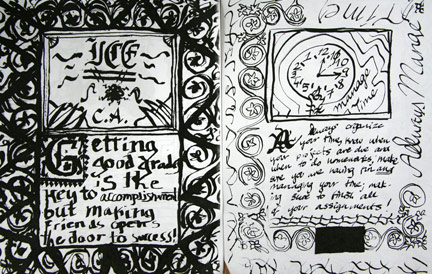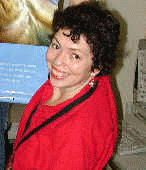 Subject: English Language Arts, Art, Advisory, History Subject: English Language Arts, Art, Advisory, History
Grade Level: 6 (can be adapted to any grade level)
Materials: Computers with Internet access, pencils, paper, calligraphy markers or calligraphy pen and ink, photocopier, white glue, and masking tape
About: Each student creates an individual illuminated page. The book is photocopied and then bound by hand. The cover of each book is individually decorated and dedicated by an experienced student for an incoming student.
Students who are completing their first year at a new school create an illuminated manuscript--a handbook for incoming students. For example, at I.C.E., a grade 6-8 school, the 6th grade of 2007-8 created ADVI.C.E.: Suggestions for Achieving while Enjoying I.C.E. by the 6th Grade of 2006-7 for the 6th Grade of 2007-8.
Each school has its own unique culture and community. Coming to a new school is a huge adjustment--socially, emotionally, and academically. The students who have completed their first year realize they have good advice for success that they wish someone had told them. The students reflect on their first year. From their own experience, they give advice to the incoming students about how to be academically successful and enjoy their new school.
At I.C.E. we introduced this project in the advisory class, a place where they often discuss community and individual issues or conflicts. If it is possible to get a list of the incoming students for the following year, let the students choose a particular student to decorate the cover for and dedicate this book to.
| Each student reflects on their first year at their new school. |
| Each student writes advice, from his/her own experience, on how to be academically successful and enjoy being part of the school community. |
| Each student looks at examples of historical illuminated manuscripts. |
| Each student is introduced to, and practices, calligraphy. |
| Each adapts a template to plan their own illustrated page of calligraphy. |
| Each student assembles a photocopied book and binds it. |
| Each student hand decorates and dedicates the book to an incoming student. |
|
|
|
| Understanding the Cultural Contributions of the Arts: Students develop an understanding of the personal and cultural forces that shape artistic communication and how the arts in turn shape the diverse cultures of past and present society. |
| Middle School |
| Arts |
| Knowing and Using Arts Materials and Resources: Students are knowledgeable about and make use of the materials and resources available for participation in the arts in various roles. |
| Middle School |
| Arts |
| Creating, Performing, and Participating in the Arts: Students actively engage in the processes that constitute creation and performance in the arts and participate in various roles in the arts |
| Middle School |
| Arts |
| Language for Social Interaction: Students listen, speak, read, and write for social interaction. They use oral and written language that follows the accepted conventions of the English language for effective social communication with a wide variety of people. As readers and listeners, they use the social communications of others to enrich their understanding of people and their views. |
| Middle School |
| English Language Arts |
| Language for Information and Understanding: Students listen, speak, read, and write for information and understanding. They collect data, facts, and ideas; discover relationships, concepts, and generalizations; and use knowledge generated from oral, written, and electronically produced texts. They use oral and written language that follows the accepted conventions of the English language to acquire, interpret, apply, and transmit information. |
| Middle School |
| English Language Arts |
|
|
|
|
|
|
|
|
|
|
|
|
|
|
|
|
|
|
|
|
|
|
| Day 1: Tips for Survival at School |
| Teacher will elicit from students a discussion on the trials and tribulations of coming to a new school |
| Students will discuss the things they wish someone had told them before coming to their new school. |
| Each student will write a list of tips for new students that will help them do well academically. |
| Each student will write a list of tips for new students that will help them enjoy being in school. |
| Each student will write a few paragraphs of advice for a new student coming to their school. |
|
| Chalkboard and chalk or dry erase board and markers |
| notebook paper |
| pencil or pen |
|
|
| In the classroom or advisory, the teacher elicits what students found difficult or challenging about coming to a new school. |
| A student volunteer writes a list of difficulties and challenges. |
| The teacher asks “What do you wish another student had told you before coming to this school?” |
| A student volunteer writes a list of advice students wish they had received before coming to this school. |
| Students review comments on board to find similarities and trends (for example, tips for doing well in a particular teacher’s class; the dangers of turning in work late; or the importance of choosing friends wisely). |
| The teacher tells students that they are going to create an advice book for new students, with real tips from experts (them) for doing well in and enjoying school. |
| Each student writes a few paragraphs of advice, in poetry or prose, for a new student coming to their school next year. |
| Students share and critique each other’s writing for grammar, clarity of thought, and level of interest. |
|
|
|
| Each student rewrites his or her advice for succeeding academically and enjoying school. |
|
| Did the class discuss the “trials and tribulations” of coming to a new school? Did the class list ideas,/advice for someone who wants to do well in their school? Did the class list ideas for making school an enjoyable experience? Did each student write his/her own paragraphs of advice? |
|
| Day 2: Magnificent Manuscripts |
| The student will view examples of illuminated medieval manuscripts. |
| The student will view examples of calligraphy. |
| The students will be introduced to calligraphy with online tutorials. |
|
|
|
| Computer terminals with Internet connection, preferably one for each student or two students to share. |
| Manuscript template form for homework. |
|
|
|
| Teacher elicits why some books are more attractive than others (example, great looking covers, catchy title, lots of graphics or illustrations, topic of interest). |
| Students view examples of illuminated medieval manuscripts on http://getty.edu/education/for_teachers/curricula/manuscripts/ and http://leavesofgold.org |
| Teacher asks students what they found unusual or interesting about the manuscripts (example: the beautiful writing, the big illuminated letters at the beginning on each manuscript, the illustrations). |
| The students discuss the form of writing on the manuscript pages: calligraphy. |
| The students practice calligraphy with online tutorials: http://gingerbooth.com/courseware/calligraphy.html |
| Students discuss what a template is and why templates are often used in book or web design (uniformity in layout, consistency, etc.) |
| Teacher gives each student a template with blank spaces to do his/her homework on. Sample template I.C.E. used can be found on: http://leavesofgold.org/learn/children/make_your_own/pagetemplate2.jpg |
|
|
|
|
| On the given template, the student will use pencil to lightly write out their advice (from previous class homework) and illustrate it. |
|
| Did students discuss what they found unusual or interesting about the illuminated manuscripts? Were students able to do the online calligraphy tutorials? Did students discuss why templates are often used in book and web design? |
|
| Day 3: Make your Mark, with Calligraphic Style! (this lesson takes 2 days) |
| Students will review the basics of the calligraphy they learned on http://vaxxine.com/mikwit/lessons/lesson1.htm and http://vaxxine.com/mikwit/lessons/lesson1.htm (Hold your pen nib at a consistent 45 degree angle to get thick and thin lines) |
| Students will practice calligraphy using calligraphy pen nibs and ink or calligraphy markers. |
| Students write and draw directly on their homework template with calligraphy pen and ink or marker. If you have tracing paper, they can place tracing paper over the template and write/draw directly on the tracing paper. |
| Any ink spills or mistakes can be corrected with white out or pro white (found in art supply stores). |
| If the names of next year’s students are available, let each student choose someone whom they will make their book cover for. |
|
| calligraphy pens and nibs and ink or calligraphy markers |
| white out or pro white |
| newspaper to cover desks |
| tracing paper (optional) and photocopied handouts |
|
| Newspaper is used to cover desks. |
| Teacher distributes calligraphy markers or calligraphy pen and nibs and ink (one per student is preferable) |
| Students review the basics of doing calligraphy (hold pen at a consistent 45 degree angles). |
| Students practice making letters by holding calligraphy markers or pens at 45-degree angle. |
| Teacher distributes tracing paper. |
| Student places or tapes tracing paper on their homework template from previous class assignment. |
| Each student recreates his/her manuscript page using calligraphy pen and nib and ink or calligraphy marker |
| A designated student uses white-out or pro white to clean up any mistakes or spills of the ink on the paper |
| If students need more time to finish their calligraphy and illustrations, arrange for a place and time to meet (or schedule additional days) |
|
|
| Each student will choose or receive a name of a student coming to the school next year (if the names are known). Each student is given a piece of paper or template (preferably card stock) to take home. For homework, each student decorates and designs a book cover, dedicated to a specific new student, if known. For the teacher: Photocopy and collate all of the students’ manuscript pages, make enough for each expected student for next year. For example, at I.C.E., we made enough copies for 60 new students. |
|
| Did each student use a calligraphy pen or marker to recreate his or her individual manuscript page? Did a selected student use white-out or pro white to clean up any mistakes? |
|
|

Meryl Meisler
mmeisle@schools.nyc.gov
I.C.E.
345 East 15th Street
New York, NY 10001
Meryl Meisler is an artist and an educator. She has taught art in the New York City public school system since 1979. At the Institute for Collaborative Education, she is Admissions Director and teaches digital and traditional art. Meryl proudly serves as a teacher representative on the Board of Trustees of Teachers Network. She has won numerous grants and awards for her teaching and artwork.
Important documents for this lesson plan.
|